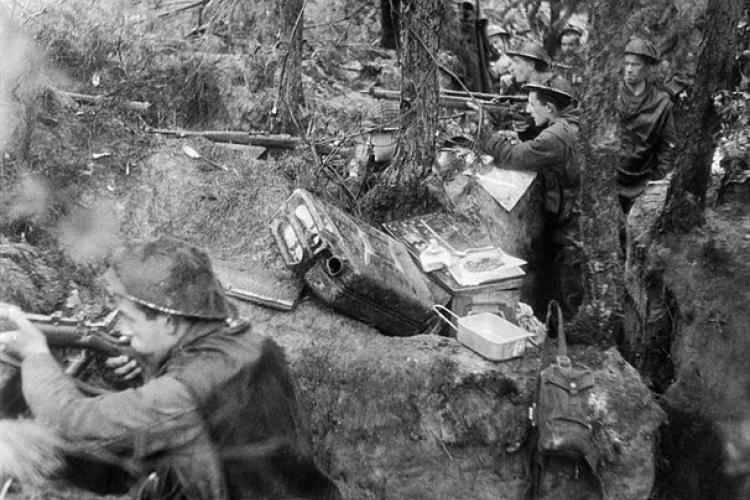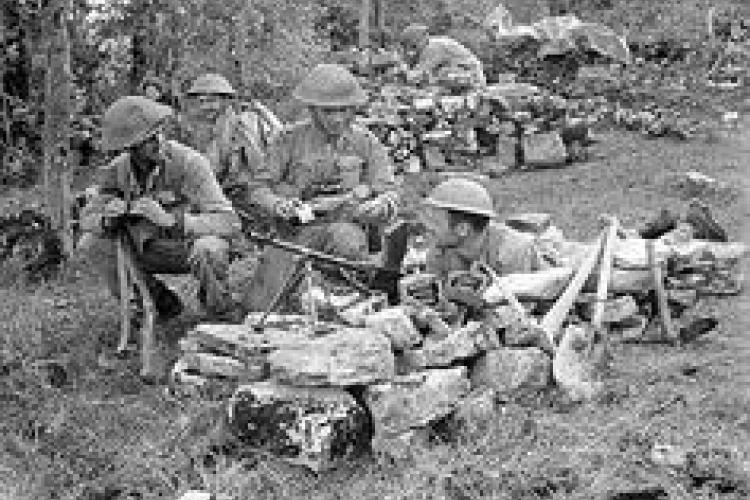Divisional Unit
Awards
SERVICE NO: A / 105054
AWARDS: 1939-45 Star, Italy Star, France – Germany Star, Defence Medal,
War Medal, Canadian Volunteer Service Medal + clasp.
DATE OF BIRTH: May 19, 1922 – Auburn – County of Huron – Ontario.
DATE OF DEATH: April 15, 1945. 22 years 11 months.
PARENTS: Mr. Martin and Jennie Youngblut (Mugford) – Auburn – Ontario
BROTHERS: Ben and Roy both lived in Goderich – Ontario
SISTER: Mrs. Beatrice Riordin – Ayr – Ontario.
CEMETERY: Holten Canadian War Cemetery – Holten –
Overijssel – Netherlands.
2 D 4
Height: 5’ 7” Weight: 145 pounds
Complexion: medium Eyes: blue / grey Hair: brown
Occupation: Farming Religion: United Church
RESIDENCE: Auburn – Ontario.
ENLISTMENT: October 29, 1942 – London - Ontario
ENLISTMENT AGE: 20 years 5 months.
Earl completed his primary education to Grade 8 and completed one year of high school and left school at the age of 17.
He worked as a labourer wrecking building for 3 months, then he went a worked as a stone crusher in a quarry and then went to work for his step father on the family farm.
Earl was a heavy smoker and liked to drink socially. He enjoyed sports as skating, hockey and baseball and he liked the theatre.
- Upon his enlistment Private Mugford was sent to No. 1 District Depot in London _ Ontario.
- November 4, 1942 - Following the initial set of interviews with the Army personnel they suggested he go into the Infantry as a Rifleman and become qualified on the 6 pounder Anti – tank gun,
- November 20, 1942 – to No. 13 Basic Training Camp at Listowel – Ontario.
- December 12, 1942 – No. 14 Basic Training Camp in Stratford – Ontario. To 6 Training Plan.
- December 23, 1942 – granted Christmas leave until December 27, 1942.
- January 15, 1943 – finished Basic Training.
- January 16, 1943 – to begin Advanced Training with courses.
- January 25, 1943 – to No. 29 Canadian Infantry Training Camp at Camp Ipperwash – Ontario.
- April 16, 1943 – qualifies in anti – tank platoon.
- April 26, 1943 – granted furlough to May 9, 1943.
- May 5, 1943 – recalled from furlough.
- Departed Canadian shores on May 14, 1943.
- Arrived in United Kingdom on May 22, 1943.
- May 23, 1943 – to No 8 Canadian Infantry Reinforcement Unit United Kingdom
- May 30, 1943 – Taken on Strength with Royal Canadian Regiment. United Kingdom
- September 6, 1943 – to War Establishment (A Wing) United Kingdom
- September 26, 1943 – qualifies for 6 pound anti – tank gun at No. 3 Canadian Infantry Reinforcement Unit United Kingdom.
- February 16, 1944 – Departed England.
In the field…..
- March 3, 1944 – Private Mugford arrived in Italy.
- April 8, 1944 – to Royal Canadian Regiment 3 Battalion Canadian Base Reinforcement Depot from the 2nd Battalion.
- May 29, 1944 – to the Royal Canadian Regiment Infantry. Here he was involved in the Battles for the Hitler Line and Gothic Line,
- On September 3, 1944, the Royal Canadian Regiment were successful in establishing a bridgehead across the Conca River and led the advance to the Misano Ridge.
- September 4 / 5 the regiment was embroiled in vicious fighting on the Misano Ridge
- September 5, 1944 – Private Mugford received wounds and is Struck off Service with his regiment.
- March 7, 1945 – Departs Italy from either Naples or Leghorn and in two days the Regiment is in Marseilles.
- March 9, 1945 – Arrived in France.
About the middle of March was when the Regiment would have reached Belgium.
- The 1st Canadian Division was involved in OPERATION CANNONSHOT which was the plan to capture the city of Apeldoorn and this began on April 11, 1945.
Each Brigade of the 1st Canadian Infantry Division had one Battalion from the Permanent Force plus two militia battalions.
The attack began in the mid afternoon of May 11, 1945 and it caught to enemy by surprise as they were thinking the attack would come from Deventer. They were not even aware of the presence of the 1st Canadian Infantry Division. The opposition came from small groups of Germans built around a few self – propelled guns. At 9 pm the Canadian bridgehead was “snug”. German reserves reached the area at midnight on night of April 11 / 12 and immediately counter-attacked.
The plan now called for the 1st Infantry Brigade which included the Royal Regiment of Canada to advance east along the axis of the Deventer - Apeldoorn railway to the airfield at Teague. The 1st Brigade moved swiftly to the west and following the death of the Commanding Officer of the 48th Highlanders, took over the lead with tanks of the 1st Hussars and on April 13, 1945 at noon were less than a mile from Apeldoorn. The Dutch Resistance reported that the mail bridge over the Apeldoorn Canal was intact in the centre of the city.
- On April 14th at first light the 1st Brigade and the 1st Hussars fought there way to the bridgehead to find it very well defended. North of the city the bridges across the Canal had been blown and the Canal itself was strong defended.
- On the evening of April 15th, Operation Cannonshot was in danger of now becoming costly piecemeal attacks. It was reported the Russians were in Berlin and the enemy was wanting a truce in parts of Holland the 1st Brigade wanted to minimize any losses in what appeared to be the final days of the war. That evening the regiment prepares to attack Apeldoorn with “B and C” Companies in the lead and the attack quickly turned into a stalemate. The forward Companies were pinned down by enemy artillery mortar and machine gun fire. The tanks of the 1st Hussars were bogged down as they tried to find an indirect route to the Canal.
During this fight for Apeldoorn cost the 1st Brigade 184 men out of the 506 the 1st Canadian Division suffered.
Regimental / Brigade diaries
a) At 11 pm on the night of April 14th the Royal Canadian Regiment and the 48th Highlanders began to advance. “B & C” Companies led the way and met small pockets of resistance which they eliminated. Into the night of April 14 / 15 one platoon was pinned down but later the enemy was outflanked.
b) At dawn on April 15th the Germans made a counter-attack against “C” Company, but the enemy was forced back. The enemy was here to fight and it was not until “A” Company along with armour attacked the Germans that their resistance began to crumble.
c) Private Mugford it is believed was with “D” Company who had been able to close up on the Canal and all the while had been under constant enemy small arms fire, mortar fire and stick grenade fire from the German defenders. Many of the German defenders were in hideaways on the outskits of Apeldoorn.
d) Apeldoorn fell to the Canadians on April 17, 1945.
e) This was the last contact with the enemy for the Royal Regiment of Canada.
- September 12, 1944 – the family received a Canadian Pacific Telegraph informing them that Private Mugford had been wounded.
- April 12, 1945 – the family received a Canadian Pacific Telegraph informing them that Private Mugford had been killed in action.
- April 30, 1945 – a letter was written to the family from A. E. Walford Major General per the adjutant General expressing deep regrets in the death of Private Mugford who was serving his country in the North - West Europe theatre of War. It goes to express deepest sympathies from the Minister of National Defence and the Army Council.
- June 24, 1945 – a letter for the family arrives with an enclosed photo of the grave of Private Mugford plus a photo of the cemetery where he is resting. This was from the Director of War Service Records.
His estate included $378.35 in a Joint Account with his mother at the Canadian Bank of Commerce, a $50.00 Dominion of Canada Bond, $160.00 in Victory Bonds, a life insurance policy with Metropolitan Life, the War Service Grant of $474.70 and the last pay of $120.25.
The personal effects returned to his family included 1 leather wallet, 10 souvenir coins, snapshots, 1 pair spectacles in case, letters, note book, photos and a ring.



